History of APM/TMB and LZOS
APM and TMB have been synonymous with high quality scopes and optics since the mid to late 1990s. In 1998, APM became the worldwide exclusive partner for APM/TMB designed LZOS manufactured optics. Based in Lytkarino in Russia, LZOS (Lytkarino Zavod Optychisovo Sticklo – translates as Lytkarino Optical Glass Works), a subcontractor for Zeiss among many others, was founded during the Soviet era to manufacture high end optics for military and research purposes. One of the primary differentiating aspects of LZOS is they actually make optical glass, allowing the company to control the whole optical assembly process from glass manufacture to final lens cell construction. A commonly used extra-low-dispersion glass in apochromatic refractors is the O’Hara made FPL-53 Super ED glass, though LZOS do not use it the construction of their Apos. Instead, they make their own Fluorite crystal substitute, the Super-ED glass OK-4. LZOS are able to make this glass in far larger sizes than O’Hara which allows them to offer triplet Apochromatic refractor objectives of up to 510mm (20”).
A common misconception among amateur astronomers, no doubt developed by all the marketing spin about ED glass, is how its low dispersion characteristics will result in superior colour correction. In fact, low dispersion (denoted by a high Abbe number) by itself does nothing and the crucial element comes from selecting a suitable mating glass with a similar refractive index but high dispersion to bring all the wavelengths back together. O’Hara does not supply a mating glass and the telescope makers are forced to search elsewhere. Many use Schott glass. However, LZOS also make a dedicated mating glass called OF-1 specifically designed to work with OK-4.
Reason for my Purchase
I first experienced just how good the image of a well corrected apochromatic refractor could be when I purchased the TMB 115 f/7 in 2004. The 4” class triplet-apo revolution was a few years old and it seemed like almost every month a manufacturer was launching a new model into the market. I was looking for a more portable scope to take to dark sky sites around the UK with my 11” fork mounted Celestron SCT being just too bulky to comfortably transport in a small car and the TMB 115 offered the same aperture, though with immeasurably superior optical quality to my first scope, a 4.5” f/8 Newtonian that I had purchased with money from a Christmas job many years earlier. The first views through that scope blew me away, vastly exceeding my expectations and it rapidly became my most used scope, both for travelling and at home due to the more manageable weight, quick set-up and cool down time.
However, there was one drawback that I had not considered at the time of purchase, and that was the length of the telescope tube. While not a problem for domestic travel, the minimum length of the tube was approximately 63cm (25”) which is longer than maximum cabin baggage size on an aircraft. Over the last few years I had found myself travelling abroad to many dark-sky locations and ruing that I did not have some form of optical aid to benefit from those sky conditions. A recently booked two week holiday to Oman in October 2012 with stays in the desert hundreds of kilometres from the nearest settlement with the potential for the darkest of skies was too much to resist and the search for an airline portable scope was on. After considering a number of different scope types and apertures that would conform to the maximum carry on dimensions, I decided to add another LZOS made triplet lens to my collection and purchased the APM TMB 105 f/6.2 LW. Delivery took a little under 3 months from order and I took ownership in late spring 2012.
The Scope
The APM TMB 105 has a 105mm aperture and 650mm focal length (f/6.2), with a tube manufactured from a phenolic compound called Kruppax 50 and aluminium with a 2” Starlight Instruments Feathertouch focuser which allows the use of 2” eyepieces for a maximum field of 4.2o. The advantages of using Kruppax 50 is the material is more sympathetic to the expansion and contraction of the lens cell than aluminium, resulting in minimal focus shift and having superior thermal properties to aluminium, it does not dew as easily. The scope weighs 6.0kg (13.2lbs) including tube rings, with a tube diameter of 135mm (dew shield diameter is 156mm and 230mm long) and minimum length for transportation of 17.3” (440mm), making it truly airline portable. The observing length is 24.01” (610mm) and is achieved via a sliding drawtube which retracts inside the tube on Teflon straps and secures with a locking screw which prevents any tilting. This sliding drawtube allows the use of any binoviewer with any diagonal without the need for any optical path correctors or Barlow (EDIT: Another owner of the 105 contacted me after reading this review to say one particular diagonal and binoviewer combination would not come to focus without an optical path corrector, that being the Baader Planetarium 2″ ClickLock Star Diagonal with his Denkmeier Denk II Binoviewers. All other diagonal combinations worked). The minimum length without removal of the focuser is 19.4” which requires the dew shield to be fully retracted though this can only be achieved either with the removal of the tube rings or with one tube ring set slight back from the end the dovetail as seen in the accompanying picture. Inside the scope there are three knife edge baffles to cut down on stray light and enhance contrast alongside flat black paint. The dew shield is also longer for the size of the scope when compared to many other models and does a fantastic job of keeping the dew at bay from the objective lens.

For the dew shield to fully retract, one tube ring needs to be set back from the end of the dovetail.
The Lens
The output of LZOS from the quality and grinding of the glass to the fully collimatable, temperature compensating lens cell and coatings is truly world class. The central element is made of the proprietary Super ED glass OK-4 mated with a special dense crown glass, using air spacing with different internal radii to control various optical aberrations including sphero-chromatism. The coatings are excellent, smoothly applied to each air-glass surface and exhibit a deep blue/violet colour which actually results in the lens almost vanishing at certain angles indicating excellent light transmission throughput which is quoted for the whole optical system as above 96%. APM/TMB and LZOS are one of the very few telescope manufacturers to actually provide an optical test certificate detailing the quality of the lens using a Zygo interferometer with associated spot diagrams. Minimum quality of 0.95 strehl is guaranteed (itself usually denoted excellent) and more often than not exceeds that level.
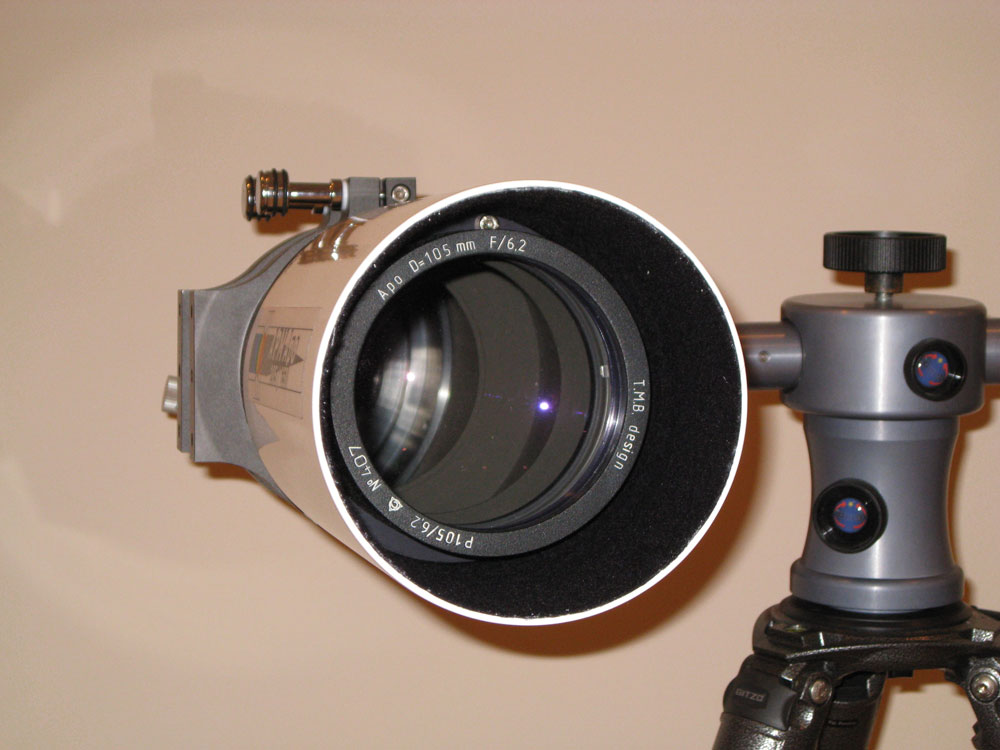
The LZOS made 105/650 lens. The immaculately multicoated lenses barely reflected a point blank flash from the camera. Knife edge baffles are visible inside
Why did Thomas Back decide on 0.95 strehl as the minimum quality criterion for optics bearing his initials? He wrote a series of articles which you can find on the web detailing a number of optically induced wavefront errors including spherical aberration and other monochromatic third order Seidel aberrations. TMB felt that one optical bench test above all others provided more valuable information about the quality of the optic and that is RMS wavefront / Strehl ratio (strehl is calculated from RMS). For example, no optical element or system is completely free from spherical aberration but the question is how well corrected for this error does the optic need to be to perform? The minimum standard for a telescope to be considered adequate is 0.80 strehl (RMS of 1/14.05 wave) and at this level it can said to be diffraction limited. At this quality level, the scope will resolve double stars of equal brightness at the theoretical limit for its aperture and will show reasonable detail and contrast on the Moon and planets. Contrast is also important for deep sky as if the spherical correction is lower than this, it will lower contrast which is of paramount importance when detecting low surface brightness objects against the sky background.
At the high end, how good does an optic need to be to allow all the detail that an aperture is able to show to be seen? TMB concluded that any optic with a strehl of at least 0.95 (RMS of 1/28 wave) will be seeing limited almost every night of the year. At this level of performance, only 4.2% of the energy from a star is misdirected into the diffraction rings instead of the Airy disk. Any light that is directed out of the Airy disk into the diffraction rings or as scatter noise will reduce contrast. Harold Suiter, in Star Testing Astronomical Telescopes page 198 (a book every amateur astronomer should own) states that at about 0.88 Strehl a telescope will become noticeable sharper than one that is only diffraction limited. At 0.95 or better, it can be considered a full planetary telescope. When considering the entire optical system (impact of secondary mirror diffraction etc) very few commercial telescopes even reach 0.88.
However, even all that talk of the Strehl ratio does not tell the whole story. At 525nm (green) it is ‘relatively’ straight forward to achieve an excellent result. The scope has to also perform well at other wavelengths and that is where the spot diagrams come in. Reviewing the provided analysis shows that many of the LZOS scopes perform equally well at both the blue and red end of the spectrum as they do at the green. This high level of control across the visible spectrum results in the super sharp performance seen in the eyepiece.
Beyond concerns over the poly-chromatic strehl performance and spot diagrams, many other factors still come into play in determining the overall performance of the telescope. How well designed and fabricated is the lens cell which holds the optical elements in alignment? Is the lens cell temperature compensating to ensure the element spacing is maintained and over what range? How well designed is the baffling system that cuts down stray light and reflections which can impact the all important contrast? What material is used for the OTA tube? Does it expand and contract out of sync causing focus shift? The theory and optical bench testing is all well and good but how does the APM 105 perform in the real world under the night sky?
The View and Testing
Images in this scope just snap to focus in a way just not seen in lesser telescopes. The focal plane is razor thin, which I prefer. There is no ambiguity of the precise focus point, you can just tell. Some observers prefer a greater depth of field and believe it is easier to achieve precise focus than with scopes like this, but with such a wonderful focuser on the backend, it is no problem at all.
Triplets will take longer to cool than a doublet of similar aperture due to the extra glass, and while the lens in the 105 is very thick and heavily curved, cool down time is good, taking about 30 minutes to produce excellent images after moving from a warm house to cool viewing location.
Once cooled the star test is virtually textbook. There was the slightest rim of pale colour when I viewed the stellar diffraction discs inside and outside of focus. Truth be told, it was not until I ran a side by side comparison with my longer focal length TMB 115 f/7 at Astrocamp in April 2013 which is colour free right through focus that I actually noticed the colour, it is was that subtle.
The intrafocal and extrafocal diffraction patterns were near identical as I could tell revealing an almost complete lack of axial aberrations with just the slightest hint of sphero-chromatism which softens ever so slightly the extrafocal diffraction pattern, a remarkable result for such a fast lens where optical aberrations are harder to control than for slower optics.
In focus performance is exactly what you would expect from a high quality apochromatic refractor. Stars are tiny diamonds on black velvet, showing absolutely no false colour of any kind and just a faint first diffraction ring. The contrast on the moon is simply stunning with the blacks, jet black and the surface showing a massive variety of hues, the images of our nearest celestial neighbour are among the best I have ever seen.
Using extremely low powers with 35mm Panoptic (3.4o degree FoV) the stars are pinpoint across the field with just the smallest amount of defocusing at the very edge, though this is likely due to the eyepiece used and inherent difficulties in correcting edge of field performance. I have very accommodative eyes and really had to study the view to see it. Astro-photographers will want to use a field flattener and APM currently recommend a couple of different options. There is a 2.5” off-the-shelf flattener which is usually sourced from Teleskop Service (TS) and is manufactured by the same company responsible for the APM 107/700 optics. However, for more extreme performance APM offer a dedicated TMB designed flattener which is manufacturer in the Moscow State University Optical Department to match LZOS Apos that provides a flat field up to 6x7cm format. APM also make their own Massimo Ricarrdi designed reducers that would convert the 105 f/6.2 into a 105 f/4.7 with a 50mm flat field.
At high powers the scope has proved itself a remarkable performer, truly worthy of being called a planetary instrument despite its short focal ratio. On one night in the desert in Oman, I was treated to perhaps the best views of Jupiter I have ever had with any telescope. Jupiter passed within 3 degrees of zenith and the atmosphere was as tranquil as any dedicated planetary observer could dream of. The image just snapped to focus at 108x (using the 6mm setting of my Nagler 3-6mm zoom) and I could immediately tell seeing was exceptional. Running quickly through the click-stops to 3mm and 216x, the image just got better and better. Without exaggeration at the magnification I felt like I was looking at a Damian Peach photograph and I lost 30 minutes to observing the king of planets despite being under magnitude +7 skies and being a dedicated deep sky observer. I wish I had taken my Televue 2x Powermate with me, but space was at a premium for that trip but it was clear the lens in this scope can take magnification well above the usually accepted maximum limits of 50-60x per inch of aperture. Unfortunately we are rarely treated to such still skies in the UK but I stand ready to really push the lens should I ever get the chance.
Many observers would consider a 4” aperture to be a little small to be a serious deep sky instrument, but under a dark sky, the power of supreme contrast comes into play. I have seen with direct vision the Flame Nebula in Orion (itself considered a litmus test for whether an attempt at the Horsehead is worth pursuing) with its wonderful dark lanes bisecting the nebula and the bright belt star Alnitak still in the field of view, when I have failed to see it in obstructed apertures as large a 12” under similar sky conditions. I was once challenged to spot Saturn’s moon Enceladus in a very deep blue sky from central London, in other words, not completely dark. At magnitude +12.2 it was proving elusive in far larger scopes, but multiple observers were able to glimpse it in the 105. I have also managed to see with averted vision two members of the Leo Triplet from Regents Park in London at a Baker Street Astronomer Star Party when the only stars visible are those brighter than magnitude about +3.50. Examples like this justify the widely held belief that the highest quality Apochromatic refractors can perform as well as larger obstructed instruments.
It is probably clear from the preceding paragraphs that I rate the optical quality of the scope very highly indeed, among the best I have used. Rather interestingly, I have had the opportunity to allow hundreds of individuals with an enormous range of astronomy experience to look through the scope which has further reinforced that view. Since taking delivery of the scope, it’s very portable nature has resulted in me taking the 105 to the monthly Baker Street Irregular Astronomers star party which is held in Regents Park. Each month a tremendous number of scopes are brought along of all different optical designs and apertures and in a very open and friendly atmosphere, the members freely move around the observing area and take a look. Given the sky conditions in central London are not exactly desirable (though still surprising what can be seen), the same showpiece DSOs and planets are usually on show in most scopes which means straight comparisons of the views are run over and over. Time and again, I hear the same comments from many who look through the 105. “Your telescope is the best one here.” Not just from experienced observers but from those who that particular night is their first time looking through a scope. I have heard other amateur astronomers’ state that they believe newcomers would be unable to tell the difference between a high quality and run-of-the-mill telescope but that does not correlate with my experience at all and speaks volumes about the quality of the view through the LZOS made lens.
I have on one occasion noted a small issue though it was transient in nature. At the beginning of one particularly frigid observing session, I took the scope from a warm 20o C house outside where it was slightly below freezing (I wear a lot of my snowboarding gear when I observe in these temperatures) and I was initially presented with slightly triangular stars indicating pinched optics, most likely the result of the lens cell contracting and putting pressure on the objective. The effect went away as the scope reached ambient temperature and for the rest of the night, the scope delivered the same excellent views I have become accustomed to. I have read a couple of reports from other observers detailing similar experiences with these Russian-made lenses but I would suggest that most observers may never experience this, as few are as silly as I when it comes to observing in very low temperatures (I love the cold).
2” Feathertouch focuser
There are a number of focuser options available for the scope, ranging from an in-house APM rack and pinion to a 3.5” Starlight Instruments Feathertouch. As airline transport was the highest priority I selected the 2” Feathertouch 2-speed Crayford mounted on the sliding drawtube. There is not a lot more that needs to be said about the focuser. Starlight Instruments Feathertouch units are generally regarded as the finest focusers available. Engineered from hard stainless steel, the action is incredible smooth and accurate and shows no image shift, even at ridiculously high magnifications or with a lot of weight hanging off the back of the scope. Each is equipped with a 1:10 microfocuser which is operated with smaller gold knob which provides precise fine adjustment which is useful for the razor thin focal plane of the f/6.2 lens.
While the minimum length for transportation is 19.4” with the dew shield fully retracted, it is possible to reduce the minimum length still further to 17.3” by removing the focuser from the drawtube. This is a simple procedure of loosening three 1mm hexagonal bolts which grip the focuser, with an Allen key. To reattach, the focuser simply slides back into the drawtube and bolts retightened. I have not experienced any issues with the focuser remaining orthogonal to the optical axis which is a testament to the high engineering tolerance of Starlight Instruments products.
Conclusion
The APM TMB 105/650 is a remarkable scope with the optical quality to satisfy the most demanding of visual observers while coming in a compact package that is airline portable. Since I took delivery of this scope it has become my most used due all the positive characteristics mentioned throughout the review and I would recommend this scope to anyone considering a 4” class refractor of the highest quality. Do I have any complaints? Perhaps just one and that is the weight and diameter of the scope. The 105 weighs almost the same (just 1lb lighter), and has the same tube diameter as my larger TMB 115 f/7 scope. The weight is understandable to a degree as the thicker, strongly curved lens contains a lot of heavy glass, but I am left wondering whether the tube could be narrower. It has been mistaken in the observing field more than once for a 5” scope. The weight and width of this scope has from time to time left me wishing I had something just a little smaller for those odd occasions when even this scope is too much to carry on trips where there are dark skies but when using it I very quickly forget these minor complaints. One member of the Baker Street Irregular Astronomers was so taken with the view through my APM TMB 105 of the Double Cluster when compared to his own 81mm triplet that he placed an order for the APM LZOS 100/800 (widely considered to be best 4” Apo available). I do not think I can place a much higher endorsement than one where an individual will purchase a c.£4,000 scope off the back of views through my similar spec 4” scope.
For more details about the full range of APM Refractors, please click here.






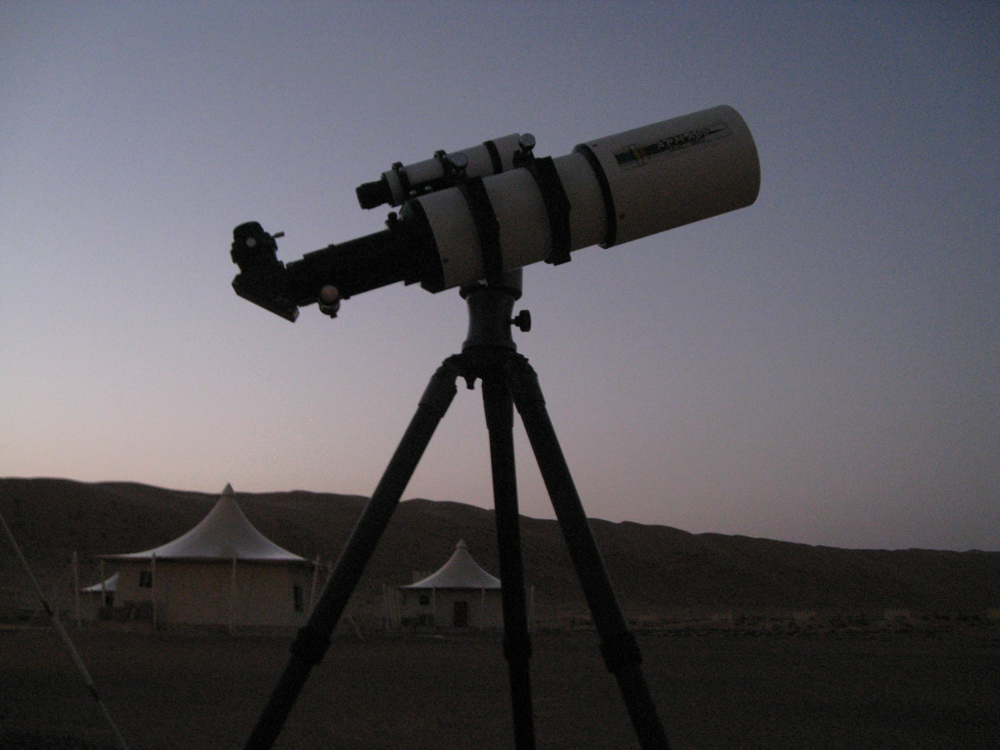
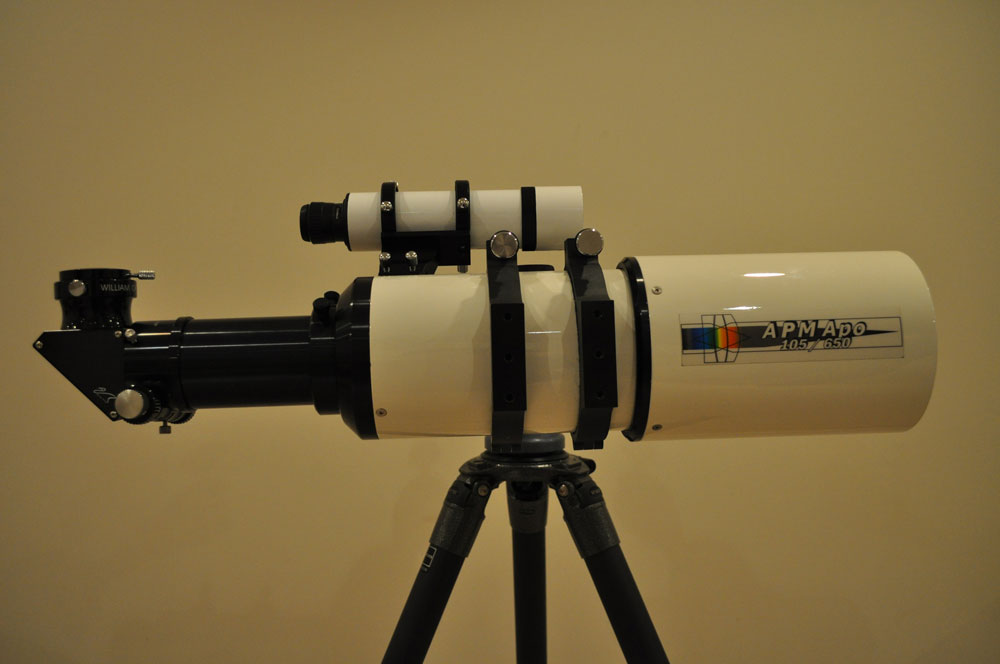
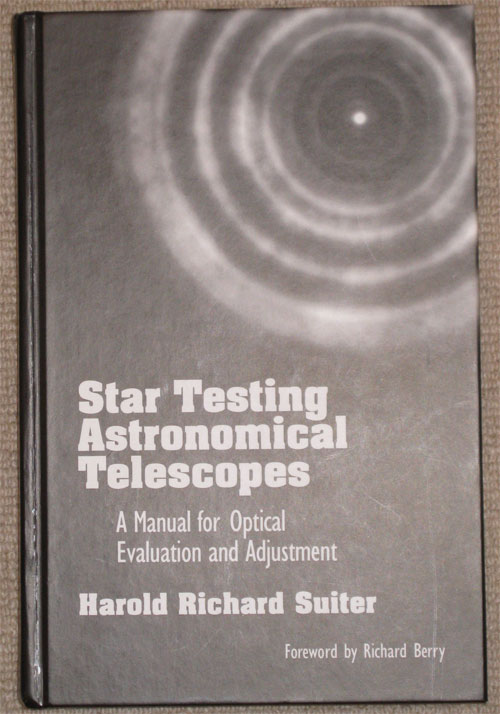
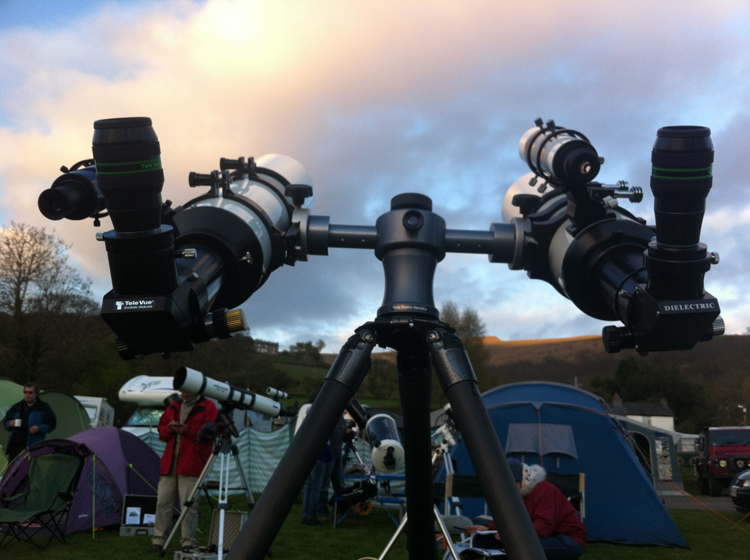
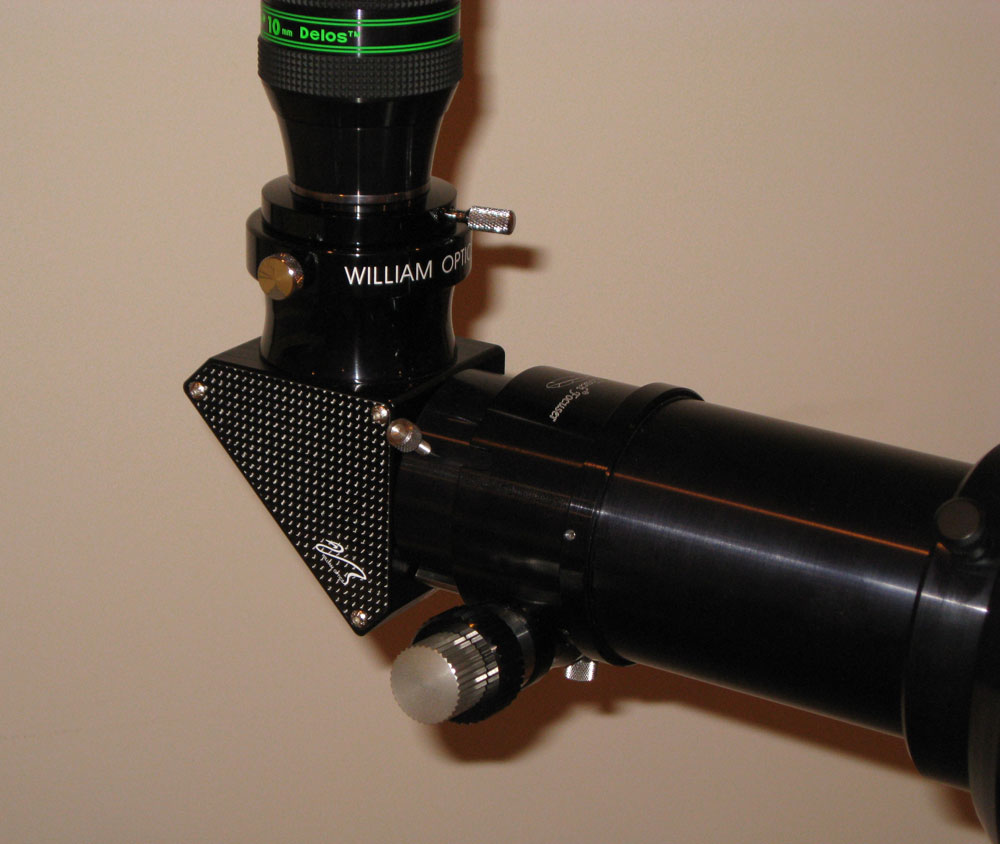


Pingback: Review of the Tele Vue Delos Eyepiece Range | Alpha Lyrae
Pingback: Gitzo Systematic Series 5 Carbon Fibre Tripod GT5532S Review | Alpha Lyrae
Pingback: hink Tank Photo Airport Security V2 Camera Bag Review | Alpha Lyrae
Pingback: Advancements In Astronomy Telescopes | Home Telescopes Reviews
Hey Matthew:
Have very much enjoyed reading the articles on your website which I came across only this week. I have been getting back into astronomy only in the past year or so. Have been very much attracted to APM refractors as I have always wanted a quality scope with a superb lens. I’ve always had 8″ Newtonian reflectors. The prices for everything good though nowadays is a bit scary. I live 30 minutes north of Toronto and just missed being able to get a 105mm F/6.2 for $1,800 last September because I did not have the cash at the time. I’m still very mad about that. These very rarely come up for sale. And the owner was handy only an hour or so drive away. Never looked through one and your review confirms that I’m looking for the right scope. Thank you.
We share the same ideas re eyepieces. A good scope needs a good eyepiece. Televue Ethos are generally too expensive. I was very interested to find out about the new Delos and their similar quality and contrast to the Ethos line. Summer last year Televue put the Delos lineup on sale for $315 each. So I bought 4 of them the 3.5, 6, 10, and 14mm. Wow they are so nice. And just by accident I saw an eBay listing from a lady in Tennesee last spring who offered a new 21mm Ethos which I got for $650. I can hardly wait to put that in the 105mm when I can find another for sale. The wonderful quality of these eyepieces matches the superb quality of the APM refractors.
All the best,
Jim McKenzie in Aurora Ontario Canada
Pingback: Tele Optic Giro Ercole Alt Az Mount Review | Alpha Lyrae
Pingback: Takahashi FS-60 Review | Alpha Lyrae
Pingback: Takahashi FC-76 DCU Review | Alpha Lyrae
Pingback: APM LZOS 115 Triplet Apo Refractor Review | Alpha Lyrae
Pingback: Tele Vue Nagler Zoom Eyepiece Review | Alpha Lyrae